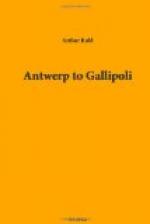Chapter XI
With The Turks At The Dardanelles
The little side-wheeler—she had been built in Glasgow in 1892, and done duty as a Bosporus ferry-boat until the war began—was supposed to sail at four, but night shut down and she still lay at the wharf in Stamboul. We contrived to get some black bread, hard-boiled eggs, oranges, and helva from one of the little hole-in-the-wall shops near by, watched Pera and its ascending roofs turn to purple, and the purple to gray and black, until Constantinople was but a string of lights across Galata Bridge, and a lamp here and there on the hills. Then, toward midnight, with lights doused and life-belts strung along the rail—for English submarines were in the Marmora—we churned quietly round the corner of Stamboul and into the cool sea.
The side-wheeler was bound for the Dardanelles with provisions for the army—bread in bags, big hampers of green beans, and cigarettes—and among them we were admitted by grace of the minister of war, and papers covered with seals and Turkish characters, which neither of us could read. We tried to curl up on top of the beans (for the Marmora is cold at night, and the beans still held some of the warmth of the fields), but in the end took to blankets and the bare decks.
All night we went chunking southward—it is well over a hundred miles from Constantinople to the upper entrance to the straits—and shook ourselves out of our blankets and the cinders into another of those blue-and-gold mornings which belong to this part of the world. You must imagine it behind all this strange fighting at the Dardanelles—sunshine and blue water, a glare which makes the Westerner squint; moons that shine like those in the tropics. One cannot send a photograph of it home any more than I could photograph the view from my hotel window here on Pera Hill of Stamboul and the Golden Horn. You would have the silhouette, but you could not see the sunshine blazing on white mosques and minarets, the white mosques blazing against terra-cotta roofs and dusty green cedars and cypresses, the cypresses lifting dark and pensive shafts against the blue—all that splendid, exquisite radiance which bursts through one’s window shutters every morning and makes it seem enough to look and a waste of time to try to think.
It is the air the gods and heroes used to breathe; they fought and played, indeed, over these very waters and wind-swept hills. Leander swam the Dardanelles (or Hellespont) close to where the Irresistible and Bouvet were sunk; the wind that blew in our faces that morning was the same that rippled the drapery of the Winged Victory. As we went chunking southward with our beans and cigarettes, we could see the snows of Olympus—the Mysian Olympus, at any rate, if not the one where Jove, the cloud-compelling, used to live, and white-armed Juno, and Pallas, Blue-Eyed Maid. If only our passports had taken us to Troy we could have looked down the plains of Ilium to the English and French ships, and Australian and French colonials fighting up the hillside across the bay. We got tea from the galley, and-with bread and helva (an insinuating combination of sugar and oil of sesame, which tastes of peanuts and is at once a candy and a sort of substitute for butter or meat) made out a breakfast.




